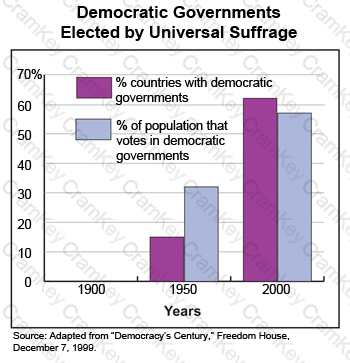| Exam Name: | GED Social Studies Exam | ||
| Exam Code: | GED-Social-Studies Dumps | ||
| Vendor: | GED | Certification: | GED Social Studies |
| Questions: | 300 Q&A's | Shared By: | haris |
Mechanization dramatically changed the clothing industry in the late 1800s.Powerful machines that were able to slice through a hundred layers of cloth at a time brought the speed of cutting clothes in line with the sewing operation.Completely automatic looms meant that one weaver could produce 400 yards of fabric in an hour.Improved cylinder presses could print from two to twelve colors at the same time.As calico florals rolled off the cylinders, one of the most expensive fabrics of the 1700s became one of the cheapest in the 1800s.
Adapted from American Heritage, December 1988, Vol. 39, 42.
The article supports which statement about the relationship of mechanization and the work world?
-- Exhibit --
The responsibilities of a citizen who lives in a democracy are similar in some ways to those of a citizen in a totalitarian state. For example, a citizen under either system is expected to pay taxes and vote.
However, there are important differences between the two systems. In a democracy, a citizen is expected to respect the rights and opinions of others. The state encourages citizens to become involved in community groups and allows political protest. In a democracy, a citizen has more rights and freedom to carry out his duties. The state exists for the good of the citizen.
In a totalitarian society, the state controls every aspect of human life, and the citizen exists for the good of the state. The primary responsibility of the citizen is to obey and follow. The citizen can vote for only government-approved candidates. The ruling party members or people who support them fill all offices and law-making bodies. Some criticism of the state may be allowed. However, any citizen activity that could interfere with the state, such as a protest march, is outlawed in a totalitarian state
Adapted from Raymond Yuen, publisher, The Way to U.S. Citizenship (Carlsbad, Calif.: Dominie Press, Inc., 1997),116; World Book Encyclopedia, Volume 19 (Chicago: World Book, Inc., 2001), 344.
-- Exhibit --

Which conclusion about citizenship in the world between 1950 and 2000 is best supported by information in the graph?
According to the article, what is a major reason people use technology to change the environment?